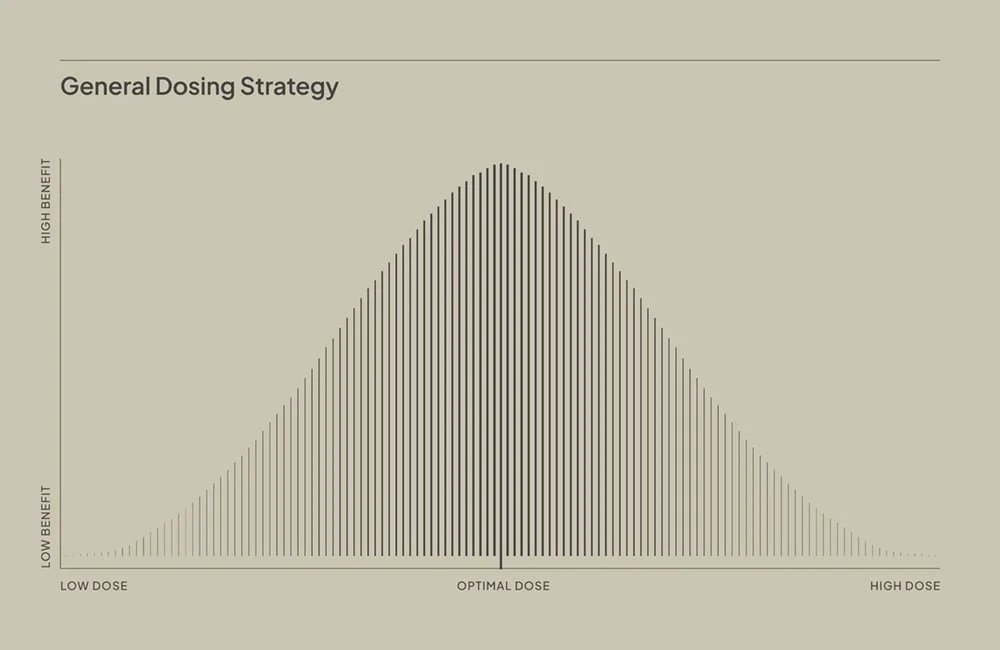
A Veterinarian’s Guide
to Prescribing CBD
This guide outlines the best practices for using CBD in veterinary care, allowing you to tailor the dosing for each patient safely and effectively.
At KINDRED, our dosing recommendations are rooted in the latest clinical research - which emphasise an individualised approach.
The Endocannabinoid System (ECS) is a complex physiological system (identified in the 1970s) that plays a crucial role in maintaining balance across multiple biological systems.
The ECS is present in all vertebrates and some invertebrates, and exists from embryonic development through to death.
The ECS is composed of three core components:
Endocannabinoids (endogenous cannabinoids):
AEA (anandamide)
2-AG (2-arachidonoylglycerol)
Receptors:
CB1 receptors - found predominantly in the central nervous system, especially on neurons.
CB2 receptors - found primarily on immune cells
Both receptor types are distributed all throughout the body.
Enzymes: These help break down endocannabinoids once their regulatory role is complete. These are then recycled.
The main function of the ECS is to maintain homeostasis in the body. The ECS acts as a neuromodulatory and immunomodulatory system. Its core functions are sometimes summarised as to: relax, eat, sleep, forget, and protect.
The ECS regulates a range of physiological processes, including:
Pain perception
Inflammation
Mood and stress response
Appetite and digestion
Immune function
Sleep cycles
Memory and learning
ECS tone can vary significantly based on various factors, including genetics, injury, inflammation, disease, or environmental factors.
Dr. Ethan Russo’s Clinical Endocannabinoid Deficiency Theory proposes that dysfunction or deficiency in ECS signalling may contribute to various chronic conditions such as migraines, fibromyalgia, and irritable bowel syndrome (IBS) in humans.
A wide range of factors can influence the functioning and balance of the ECS. These include lifestyle-related elements such as exercise, which has been shown to increase endocannabinoid levels and support mood regulation. Diet also plays a crucial role, particularly the intake of essential fatty acids, which serve as precursors for endocannabinoid synthesis.
Certain pharmaceuticals can modulate ECS activity, either intentionally or as a side effect, by interacting with cannabinoid receptors or affecting endocannabinoid metabolism. Chronic stress can disrupt ECS balance, potentially contributing to anxiety, depression, and other health issues.
Additionally, integrative therapies like acupuncture and massage therapy have been found to indirectly support ECS function by reducing stress and promoting homeostasis within the body.
Together, these factors illustrate the dynamic nature of the ECS and its responsiveness to both internal and external influences.
The Endocannabinoid System (ECS)
Phytocannabinoids
CBD Isolate contains about 99% pure CBD, whereas Full Spectrum CBD contains the whole plant extract.
CBD Isolate gives the most repeatable result as it contains only pure CBD, and nothing else.
Full Spectrum CBD contains over 98% CBD and less than 2% naturally occurring terpenes, flavonoids and phytocannabinoids, including trace amounts of THC. When the entire contents of the plant are used together in this way, there is believed to be a synergistic effect, which is commonly known as the ‘entourage effect’. This means that the various plant compounds work together synergistically to produce a greater overall effect than any single compound alone.
There is also the option of a CBD/THC isolates blend, which contains CBD isolate and THC isolate in 100:1 ratio of CBD/THC. In Australia, a maximum of 2% THC is allowed with other phytocannabinoids in compounded preparations for veterinary use.
CBD Product Differences
CBD is generally considered to be safe and well tolerated. As per the World Health Organisation, CBD does not have abuse potential or cause harm. Both CBD and THC have a very high therapeutic index, meaning their lethal doses are extremely high - in fact, they remain undefined.
Safety
CBD is metabolised by the liver and undergoes the hepatic first pass effect, which can lead to variabilities in metabolism from one patient to the next. CBD is not believed to affect renal function.
Metabolism
CBD inhibits certain cytochrome P450 enzymes in the liver, which may affect how other medications are metabolised. When CBD is used with certain drugs, such as Benzodiazepines, Gabapentin, Acepromazine, Tramadol, Trazodone and Phenobarbital, there can be increased lethargy and sleepiness.
A 2021 pharmacokinetic interaction study tested the interaction between CBD and phenobarbital in healthy dogs. No significant interactions were found, therefore, dose escalation of CBD or adjustment of phenobarbital in dogs is not recommended on the basis of these findings.
In theory, there is a potential theoretical risk of serotonin syndrome when CBD is combined with SSRIs or Trazodone, however, there have not been any documented reports of this.
Drug Interactions
CBD is usually unsuitable for patients with severe hepatic dysfunction or disease.
CBD is not recommended for chronis use in young, pregnant and breeding animals due to the potential impacts on developing endocannabinoid systems.
CBD and THC concentrate in breast milk so they should be avoided in lactating animals where possible.
Caution / Contraindications
CBD is usually well tolerated by pets.
Side effects are rare and are usually mild in nature - including gastrointestinal upset, i.e. soft stools in dogs and vomiting in cats. Giving the oil with food, and titrating the dose up slowly, help to mitigate this.
When THC is present, sedation or drowsiness may occur.
Long-term use of CBD can sometimes cause elevations in the liver enzymes, ALP, and less often, ALT. These changes are reversible and no liver damage occurs. See Blood Monitoring for more information.
A 2022 study tested the pharmacokinetics of escalating CBD doses in cats, and the following effects were observed: excessive licking, head-shaking, and less commonly, pacing, chomping and gagging.
Side Effects
Studies have shown that cats absorb and metabolise CBD differently to dogs. It is thought that cats may require higher doses to maintain what we consider a therapeutic blood level of CBD, but at this time we recommend the same dosing as dogs. As always, monitor each patient and adjust the dose according to their individual response.
CBD in Cats
CBD’s effects are highly individual, so regular monitoring and dosage adjustments are necessary. For animals on chronic CBD therapy, routine liver enzyme checks are recommended. Take a pre-administration blood panel and monitor bloods on a regular basis (every 3—6 months).
Elevated ALP (alkaline phosphatase) levels have been noted in some dogs on high dose CBD over an extended period.
Less frequently, elevated ALT (alanine transaminase) has been observed in some cats on long-term CBD therapy.
These elevations are reversible, and no liver damage has been observed from CBD use.
CBD products should only be prescribed when these parameters are within the normal range.
Monitoring Bloods
Our CBD oils are formulated for oral use. They may be mixed with food, or administered directly into the mouth using a small syringe. CBD oil is best given with lipid-rich foods (e.g. peanut butter) to enhance absorption.
Administration
MCT (medium chain triglycerides) oil, derived from coconut oil, is the universally recommended carrier oil for CBD as it is believed to yield the best bioavailability. However, some pets may have sensitivities to coconut, in which case we recommend using an alternative carrier, such as olive oil, sunflower oil or hemp seed oil. In our experience, we have found that some cats prefer the taste of sunflower oil to MCT oil.
Carrier Oils
Flavouring may be added to any of our CBD oils, e.g. chicken, beef, tuna.
CBD Isolate is odourless and tasteless, however Full Spectrum CBD has a smell and taste so we would recommend adding a flavour to the latter. Choose one of our flavouring options, include it on the script, and the pharmacy will incorporate it into the compounded oil.
Flavourings
Approximately 140 phytocannabinoids have been identified in the Cannabis plant, each interacting with the endocannabinoid system (ECS) in distinct ways. The most abundant in the plant, and extensively studied of these - often referred to as major cannabinoids - are CBD and THC.
Cannabidiol (CBD)
CBD is a non-intoxicating phytocannabinoid derived from the Cannabis plant. It interacts indirectly with CB1 and CB2 receptors (by allosteric modulation) and it modulates other receptor systems, including the GABA, glutamate, serotonin, opioid, and dopamine pathways.
Main effects of CBD:
Anti-inflammatory
Anxiolytic (works at 5-HT receptors)
Analgesic (mild to moderate pain control)
Anticonvulsant
Supportive and regulatory effects (acts as an endocannabinoid reuptake inhibitor)
CBD is non-psychoactive, and can dampen THC’s psychoactive effects.
CBD is very safe and generally well tolerated, with minimal mild side effects.
delta-9-Tetrahydrocannabinol (THC)
THC binds directly to, and acts as a partial agonist at, the CB1 receptors. THC also offers many medicinal benefits:
Strong anti-inflammatory properties
Strong analgesic
Antineoplastic
Anti-emetic
Neuromodulatory (at CB1 receptors)
Appetite stimulation
In controlled, low doses, it may be clinically useful, however, improper dosing - especially in veterinary patients - can lead to adverse effects. THC toxicity in normally observed at much higher doses than what is used in veterinary preparations, for example, upon ingestion of human products.
Minor Cannabinoids
In addition to these major cannabinoids, there are numerous minor cannabinoids, including cannabidiolic acid (CBDA), cannabigerol (CBG), cannabinol (CBN), and tetrahydrocannabinolic acid (THCA), which also demonstrate a range of potential therapeutic effects. While our understanding of these lesser-known cannabinoids remains limited, research into their properties and benefits is actively ongoing.
Store the oil in its original container in a cool, dry place and keep away from direct sunlight. Do not store oil in the fridge. Keep the bottle upright.
Storage
General Dosing Strategy:
Start Low, Go Slow
Dosing of CBD is always patient-dependant. Not all patients respond the same to standardised dosing so vets must tailor the dosage on a case-by-case basis.
When introducing CBD, it’s essential to follow the ‘start low, go slow’ method.
CBD has a biphasic dosing curve, so it’s best to begin with a low dose and make slow, incremental increases to find the optimal dose, whereby the desired therapeutic effect is achieved and the side effects are minimal. The optimal dose varies from patient to patient.
CBD Dosing:
An Individualised Approach
As there is no universal dose of CBD for animals, an individualised approach is key.
Dogs and cats should be dosed the same way.
Typically, most conditions respond well to CBD doses of 0.5—2 mg/kg BID.
Higher doses are required for cancer, epileptic and palliative patients.
Start low and go slow. Titrate to effect.
Please note: BID refers to every 12 hours. CBD is best given with food.
For Most Conditions
Except Cancer, Epilepsy and Palliative Care
A Start at 0.5mg/kg BID.
B Monitor response.
C Double dose each week, if needed, to see if there is a better effect, i.e. 0.5 mg/kg → 1 mg/kg → 2 mg/kg, etc.
For Cancer, Epilepsy
and Palliative Care
A Start at 2.5 mg/kg BID.
B It is prudent to give this dose SID (tarde) for the first few days, then increase to BID.
C SID (tarde) for the first few days, then increase to BID.
D Monitor response.
E Increase to 5 mg/kg BID, if tolerated.
F Increase dose even higher if needed and if tolerated.
A scientific report (2018) tested CBD doses of 10—20 mg/kg per day given to healthy dogs to investigate adverse effects and it was found that these doses were well tolerated by the dogs.
Condition
Starting Dose
Usual First-Line CBD Treatment
Chronic Anxiety
0.5 mg/kg BID
CBD Isolate
Atopic Dermatitis
0.5 mg/kg BID
CBD Isolate
Cognitive Decline
0.5 mg/kg BID
CBD Isolate
Osteoarthritis
0.5 mg/kg BID
CBD Isolate
Chronic Pain
0.5 mg/kg BID
Full Spectrum CBD
Seizures / Epilepsy
2.5 mg/kg BID
CBD Isolate
Cancer Symptoms
2.5 mg/kg BID
Full Spectrum CBD
Anti-Cancer
2.5 mg/kg BID
Full Spectrum CBD
Palliative Care
2.5 mg/kg BID
Full Spectrum CBD




